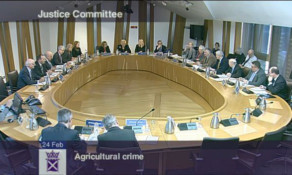The growing problem of rural crime has been exacerbated by the centralisation of Scotland’s police force to become Police Scotland, it has been claimed.
The allegation, submitted to the Scottish Parliament’s Justice Committee by NFU Scotland, was raised by committee chairwoman Christine Grahame during a round-table session at Holyrood yesterday, which was established to gather evidence on the theft of farming equipment, fuel, tools and livestock across Scotland.
According to NFUS, although the union enjoys a good working relationship with Police Scotland, there is no joined-up reporting and recording system for instances of rural crime.
“It is therefore difficult to obtain an accurate picture of the scale of rural crime between Scotland’s regions beyond figures reported to Police Scotland and anecdotal evidence,” the NFUS said.
The union said while members appreciate that police resources are stretched, they regularly express “frustration” that police know who the perpetrators of rural crimes are yet do not have the power, available manpower nor resource to respond quickly to calls or take proactive action to stop it happening again.
This issue, it said, has been “somewhat exacerbated since the centralisation of the police service”.
Refuting the accusation, detective chief superintendent Robbie Allan, of Police Scotland’s Specialist Crime Division (SCD), said the creation of one consolidated police force in Scotland has actually had a positive impact on rural crime.
“Police Scotland has not taken any officers away from the local and rural communities far from it,” said DC Allan, who has responsibility for coordinating activity which targets crimes across each of Police Scotland’s 14 divisions.
“Instead, these rural police officers are now backed up by a coordinated central support system that is much better positioned to identify whether a rural crime may be a one-off incidence or could potentially be linked to the activities of a wider organised crime network.
“Local response and local officers remain the most effective method of evidence gathering in terms of rural crime.
“The formation of Police Scotland has not changed that.
“We now have a far more coordinated picture of what is going on in Scotland.”
He said SCD is working hard to identify the organised crime networks that are fuelling rural crime: “It’s the players that are facilitating the sale of stolen machinery and livestock that we really want to eliminate.”
According to NFU Mutual regional director Martin Malone rural crime cost the Scottish economy an estimated £1.9m in 2013, with fuel, tools and quad bikes the most commonly targeted items that year.
Large value items, such as tractors and combines, stolen from the UK have been recovered as far away as Poland, Afghanistan and Africa.
But over recent years, rustling has also become a far more prevalent issue too, he added, with 25 incidences of livestock theft in Scotland in 2013 costing £82,000 and 26 incidences in 2014 valued at £127,800.
Providing evidence during session Linlithgow farmer and NFUS Legal and Technical committee chairman Jamie Smart said at a local branch meeting, in December, a show of hands proved that between 70% and 75% of union members had been subjected to rural crime over the last 12-month period.
But, he also cautioned the Justice Committee that intimidation will leave many farmers feeling “vulnerable” and therefore reluctant to report incidences of rural crime to the authorities.
“I was personally threatened on my own farm by an individual when I questioned him with regards to wildlife crime,” said Mr Smart.
“This person told me in no uncertain circumstances that if I reported him to the police, my farm buildings would be at ‘significant risk’ from fire.
“Whilst I did report the incidence, the threat hung as a great worry for many of the following weeks.
“Whether threats are idle or otherwise, farmers do feel very vulnerable.”
DC Allan stressed it is of the utmost importance that farmers report not only any incidence of crime but of any act of intimidation also.
He also said more farmers should be encouraged to pursue “target hardening” techniques including the installation of CCTV systems on farm buildings and tracking devices, immobilisers and data tags on farm vehicles and machinery to help prevent rural crime from happening.
During the round-table session, the Justice Committee took evidence from Tony Dysart, Crown Office and Procurator Fiscal Service; Jamie Smart, chair, Legal and Technical Committee, NFUS; Martin Malone, Regional Manager Scotland, NFU Mutual;
Detective Chief Superintendent Robbie Allan, Divisional Crime, and Detective Sergeant Lynn Nelson, Police Scotland; Dr Robert Smith, Robert Gordon University; Douglas Scott, Senior Policy Adviser, Scottish Borders Council; Teresa Dougall, South East and South West Regional Manager, Scottish Land and Estates.
